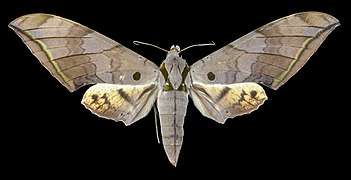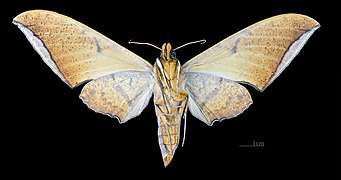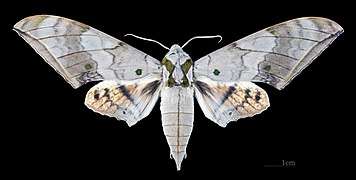Ambulyx substrigilis
Ambulyx substrigilis, the dark-based gliding hawkmoth, is a species of moth of the family Sphingidae. It was described by John O. Westwood in 1847.[2]
| Dark-based gliding hawkmoth | |
|---|---|
_(4190785427).jpg) | |
| Scientific classification | |
| Kingdom: | Animalia |
| Phylum: | Arthropoda |
| Class: | Insecta |
| Order: | Lepidoptera |
| Family: | Sphingidae |
| Genus: | Ambulyx |
| Species: | A. substrigilis |
| Binomial name | |
| Ambulyx substrigilis | |
| Synonyms | |
| |
Distribution
It is known from Sri Lanka, India, Nepal, Bangladesh, the Andaman Islands, the Nicobar Islands, Thailand, Vietnam, China (Hainan Island), Malaysia (Peninsular, Sarawak), Indonesia (Sumatra, Kalimantan) and the Philippines.[3]
Description
The wingspan is 96–120 mm. It can be distinguished from other Ambulyx species by the large black or tawny basal patch of the hindwing upperside. The dorsal line of the abdomen is distinct. The costal sub-basal spot on the forewing upperside is usually absent, but sometimes nearly as large as the one behind the cell.
 Female dorsal view
Female dorsal view
(from the collection of the MHNT) Female ventral view
Female ventral view
(coll. MHNT) Male dorsal view
Male dorsal view
(coll. MHNT) Male ventral view
Male ventral view
(coll. MHNT)
Biology
The larvae have been recorded feeding on Aglaia littoralis in India.
Subspecies
- Ambulyx substrigilis substrigilis (Sri Lanka, India, Nepal, Bangladesh, Andaman and Nicobar Islands, Thailand, Vietnam, China (Hainan Island), Malaysia (Peninsular, Sarawak), Indonesia (Sumatra, Kalimantan), Philippines)
- Ambulyx substrigilis aglaia (Jordan, 1923) (India)
In The Fauna of British India, Including Ceylon and Burma: Moths Volume I, the species is described as follows:
The hind wing crenulate. Pale ochreous or greyish brown to purplish brown in color; an olive-green band between the antennae; lateral olive-green bands on the thorax meeting on metathorax; abdomen with two olive blotches on the fifth segment, and one on the seventh in some specimens; sides of palpi and pectus ferruginous; some specimens with a ferruginous line down the vertex of abdomen. Fore wing with a basal olive speck; a subbasal olive blotch on the costa, and another below the median nervure, the former being obsolete in some of the forms; two irregularly dentate, more or less obsolete antemedial lines, and two similar lunulate postmedial lines; a curved band from apex to outer angle, the inner part of which is light, the outer dark. Hind wing ochreous, mottled with fuscous; an erect medial, and curved more or less lunulate postmedial band; some specimens with the anal half of the margin dark. ... Larva pale green with darker granular spots; a white dorso-lateral line; pale yellow oblique streaks on 5th to 10th somites; horn purple with white granular spots.
— The Fauna of British India, Including Ceylon and Burma: Moths Volume I[4]
References
- "CATE Creating a Taxonomic eScience - Sphingidae". Cate-sphingidae.org. Retrieved 2011-10-26.
- "Ambulyx substrigilis (Westwood, 1847)". International entomological community. Retrieved 5 July 2016.
- Pittaway, A. R.; Kitching, I. J. (2018). "Ambulyx substrigilis substrigilis Westwood, 1847 -- Dark-based gliding hawkmoth". Sphingidae of the Eastern Palaearctic. Retrieved December 13, 2018.
- Hampson, G. F. (1892). The Fauna of British India, Including Ceylon and Burma: Moths Volume I. Taylor and Francis – via Biodiversity Heritage Library.